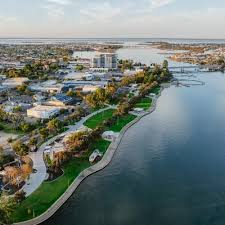This week we are looking at the second largest city in Western
Australia this city is Mandurah, it is located approximately 72 kilometres (45
miles) south of Perth. It is known for its coastal location, marine life,
and as a popular tourist destination.
It is also known for the Peel-Harvey Estuary with its abundant
wildlife and migratory waterbirds. The Mandurah Community Museum features
exhibits on the Peel region’s history. Halls Head Beach has a large resident
dolphin population. To the south, Yalgorup National Park is home to
thrombolites, rare, rock-like microorganism formations, at Lake Clifton.
Mandurah was initially established as a townsite in 1831,
following the arrival of Thomas Peel's settlement in the area. While a
townsite was laid out in 1831, the area remained largely undeveloped until the
post-war boom of the 1950s and 60s, when it began to grow as a fishing village
and later a popular resort and retirement destination. The area's name,
Mandurah, is derived from the local Aboriginal word "mandjar,"
meaning "meeting place".
The traditional owners of Mandurah are the Bindjareb people
of the Noongar Nation. The City of Mandurah acknowledges and respects the
Bindjareb people as the first peoples of the land. They are also sometimes
referred to as the Binjareb/Pinjarup people. The Noongar name for Mandurah
is Mandjoogoordap, which means "meeting place of the heart".
The City of Mandurah has a population of more than 99,000
residents as of June 30, 2023. This makes it the largest regional city in
Western Australia. The city's population has been steadily growing, with
an increase of 3.82% in the year leading up to June 2023. Projections indicate
further significant growth, with an expected increase of over 23,000 residents
between 2021 and 2046








Interesting- your nation is so thoughtful about your first peoples- a lesson North America could take...
ReplyDeleteIt makes me proud to read that
DeleteI love that it's called 'Meeting Place of the Heart,' Jo-Anne. Yes, I love that Australia recognizes their original inhabitants with such grace. I just read an article the other day that the vast majority of our States are named for what the Native Americans called them. Blessings!
ReplyDeleteWell when you consider how badly they were treated by the first Europeans they deserve to be recognised
DeleteI agree about the first peoples! And Meeting Place of The Heart is such a wonderful name. :)
ReplyDeleteYes the name has a nice meaning
DeleteIt's rather a nice area there, Jo-Anne.
ReplyDeleteI have never been to W A but would like to
Delete